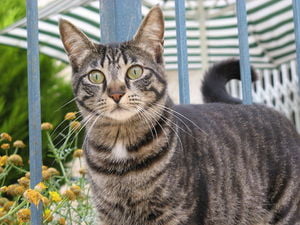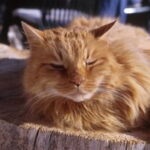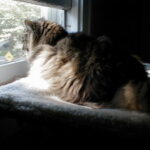Due to the complexities of feline genetics, many cats display more than one coat color at once. The terminology related to cats with multiple coat colors can be confusing, since some cat owners mislabel their cats’ markings. Cat fanciers assign certain direct labels to different types of color markings on cats, to make these patterns more distinguishable and understandable to breeders and owners.
Tabby Cat Markings
The majority of cats have highly visible striping or spotting on their bodies, and are considered to be tabby by owners and breeders. Mackerel tabbies, with narrow, parallel stripes, are the most common, while classic tabbies with marble-like swirls are also a frequent sight at cat shows. Spotted tabbies, with uniform spots on their bodies, are somewhat rare. The term tabby is also used to described specific markings or blotches that contain these stripe features.
Tortoiseshell Cat Markings
A cat is defined as tortoiseshell if its entire body is flecked with red and black markings, although tortoiseshell cats carrying a special gene, called “dilute tortoiseshells” may instead be cream and blue. Often, tortoiseshells will also display white markings and can also be classified as mitted, tuxedo, or locket tortoiseshell cats, and those with substantial white markings are often called calico. Nearly all these cats are female owing to the complex, sex-linked nature of cat color coat genetics.
Tuxedo Cat Markings
A cat is considered to have tuxedo markings if it is predominantly black or tabby, but with a white chest, belly, and paws. Tuxedo cats have been made famous by children’s cartoons, with Sylvester of Looney Tunes being perhaps the most famous of the type. In the UK, tuxedo cats are also sometimes called Billicats, although this is a nickname, not a cat fancier’s term.
Mitted Cat Markings
Cats that are uniformly colored except for their white paws are called mitted. Mitted cats can also have “lockets” (see below) and are often said to have “socks” or “mittens” by their owners and breeders. Many cat color types can include mitted cats, including tortoiseshells, solid cats, all forms of tabby, and even pointed cats.
Locket Cat Markings
Some cats are otherwise tabby or solid-colored, but have a small white “locket” on their chests. Cats’ lockets can be almost any shape, including heart, diamond, and even moon-shapes, although it is nearly impossible to breed a cat to show a specific locket shape.
Harlequin Cat Markings
Also called “moo cats” or “cow cats” because of their coat pattern’s resemblance to Holstein cattle, Harlequin cats display mostly white bodies with large blotches of color. Although this color can be nearly any shade, including tabby or even tortoiseshell, most Harlequin cats have black blotches.
Mask-and Mantle Cat Markings
Two-tone cats are considered to be mask-and-mantle cats if they have black markings that cover their upper face, as if to form a mask. Additionally, a mask-and-mantle cat will have a single, unified marking that extends entirely down the cat’s back, up to and including his tail. These are also called “black mask cats” when the marking is entirely black.
Cap-and-Saddle Cat Markings
A cat with cap-and-saddle markings looks very similar to a cat with mask-and-mantle markings, but its “mantle” is interrupted with white markings, leaving its forehaunches white. These cats have colored markings on their ears and sometimes “masks” covering their eyes, as well as a single, unified marking that covers their backside and tail. Like Mask-and-Mantle cats, they are sometimes labeled “black mask cats” if their markings cover the face and are black.
True Bicolor Cat Markings
Although all cats that display two colors can be called “bicolors”, the specific definition of bicolor, in cat fanciers’ terms, includes only cats with coloration that looks like a cross between cap-and-saddle markings and mask-and-mantle markings. Bicolor cats have a near fifty-fifty amount of white and another color, with their black markings extending down to their thighs, but not into their legs, and their white markings extending evenly onto the cats’ upper haunches. True bicolor cats are the preference of most cat fanciers in cat shows.
Van Pattern Cat Markings
Cats with van markings are nearly solid white, and may indeed appear to be all-white at first glance. Their colored markings appear exclusively on their heads and tails, as can be seen in the popular Turkish Van breed. Some calicos also display van-patterns
Button-Type Cat Markings
Cats are said to have “buttons” if they are predominantly a single color or tabby color, but also have several small, white blotches on their inner abdomens, chests, or bellies. This gives the appearance of tiny buttons. Some cats’ buttons also trail upward to the chest, forming additional buttons and possibly a locket.
Pointed Cat Markings
Some cats display a feature known as temperature-sensitive albinism, which makes the cat’s face and feet darker than the rest of its body. This is most common (and most well-known) in Siamese cats, but the trait can actually occur in cats of mixed ancestry or other breeds. The marking is specifically labeled based on the appearance of the colored part of the body. “Lynx point” cats with tabby points and “tortie point” cats with tortoiseshell points are common, in addition to the well-known seal-point breeds.
The complex nature of cat genetics and the passion of the cat fanciers’ hobby both lead to a degree of confusion and vagueness regarding the terminology of cats’ markings. However, owing to a more distinct effort to delineate and define cat markings, more breeders and owners reaching a more level ground of definition.
Source Used:
Common Cat Colors. Cat Fancier’s Association. Accessed 24 Dec 08.




